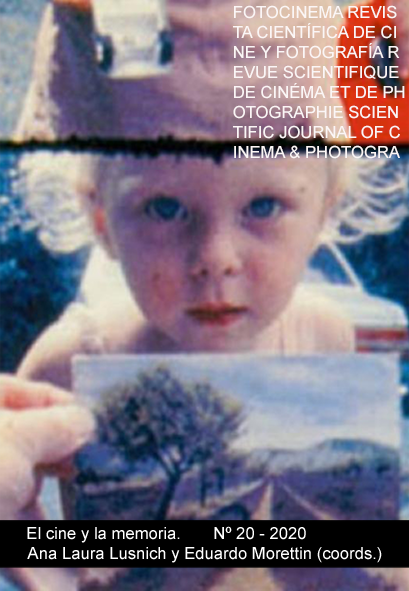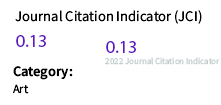The place of memory in the cinema of Jonas Mekas
DOI:
https://doi.org/10.24310/Fotocinema.2020.v0i20.7600Keywords:
Mekas, Memory, No-place, MemoriesAbstract
This article aims to provide an approach to the key works by Jonas Mekas (2000) As I Was Moving Ahead Occasionally I Saw Brief Glimpses of Beauty, reflecting on the concept of memory and its visualitation on the selected film. Thus, starting with an earlier analysis of the film and taking the post-modernity´s discourse on memory and space as its reference, this essay attempts to relate the work and discourse on filmed memory of Mekas with the assumptions of Marc Augé or Pierre Nora, among other authors. Thereby, the object of the study of memory, as well as the concepts associated to the so-called new narrative will acquire a stronger conceptual dimension and will shed light on the key works of the Lithuanian filmmaker.
Downloads
Metrics
Publication Facts
Reviewer profiles N/A
Author statements
Indexed in
-
—
- Academic society
- N/A
- Publisher
- Universidad de Málaga
References
Adams Sitney, P. (1978). Autobiography in Avant-Garde Film. En Adams Sitney, P.(Ed.). The Avant-Garde Film: A Reader of Theory and Criticism. Nueva York: University Press.
Álvarez Asiáin, E. (2011). De Bergson a Deleuze: la ontología de la imagen cinematográfica. Eikasia, 93-111.
Araújo, N. (2010). Textos de teorías y crítica literarias: del formalismo a los estudios poscoloniales. Barcelona: Anthropos Editorial.
Augé, M. (2000). Los no lugares, espacios del anonimato: Una antropología de la Sobremodernidad. Barcelona: Editorial Gedisa.
Augé, M. (2001). No-lugares y espacio público. Quaderns d'arquitectura i urbanisme, 231, 6-15.
Barthes, R. (1987). La muerte del autor. El susurro del lenguaje, 65-71.
Bazin, A. (1990). ¿Qué es el cine? Madrid: Ediciones Rialp.
Bellour, R. (2011). Between-the-Images. París: JRP Ringie.
Bordwell, D. (2012). Return to Paranormalcy. Observations on Film Art. Disponible en: http://www.davidbordwell.net/blog/2012/11/13/return-to-paranormalcy/
Boym, S. (2001). The Future of Nostalgia. Nueva York: Basic Books.
Brea, J.L. (2010). Las tres eras de la imagen. Madrid: Ediciones Akal.
Cuevas, E. (2003). Imágenes familiares: del cine doméstico al diario cinematográfico. Archivos de la Filmoteca, 45, 128-141.
Deleuze, G. (1987). La imagen-tiempo. Barcelona: Paidós.
Deleuze, G. (2002). Últimos textos: El “Yo me acuerdo”, La inmanencia: una vida Contrastes. Revista Interdisicplinar de Filosofía, 7, 219-237.
Dorsky, N. (2016). El cine de la devoción. Sevilla: Lumière.
Drummond, P. (1979). Notions of Avant-garde Cinema. En P. Drummond (Ed.), Film as Film: formal experiment in Film 1910-1975 (pp. 9-19). Londres: The Arts Council of Great Britain.
Foucaul, M. (1968). La palabra y las cosas: una arqueología de las ciencias humanas. México: Siglo XXI Editores.
García, L. A. (1998). El espejo, la máscara y la daga (Tren de sombras, José Luis Guerín, 1997). Banda aparte, 23, 33-37.
García Catalán, S. & Sorolla Romero, T. (2014). Morfologías de nuestros áridos días felices. L'Atalante. Revista de estudios cinematográficos, 17, 46-52.
Gonçalves, O. (2014). Narrativas sensoriais. Ensaios sobre cinema e arte contemporânea. Rio de Janeiro: Editorial Circuito.
Hick, J. (2007). Dziga Vertov: Defining Documentary Film. Nueva York: I.B Tauris & Co.
Konigsberg, I. (2004). Diccionario Teórico del Cine. Madrid: Ediciones Akal.
Martín, J. (2010). La imagen-movimiento. Deleuze y la relación Beckett-Bergson. Arete, 22.
Mendoza García, J. (2005). Exordio a la memoria colectiva y al olvido social. Athenea Digital, 8, 1-26.
Mendoza García, J.. (2006). La edificación colectiva de la memoria. Uaricha, 18-27.
Mitchell, W.J.T. (2019). La ciencia de la imagen: Iconología, cultura visual y estética de los medios. Madrid, Akal.
Mitry, J. (1997). The aesthetics and psychology of the cinema. Bloomington: Indiana University Press.
Nietzsche, F. (1874). Consideraciones Intempestivas II. De la Utilidad y de los Inconvenientes de los Estudios Históricos, para la Vida. Madrid: Miguel Ángel Aguilar, 1932.
Nora, P. (1989). Between memory and history: Les lieux de mémoire. Representations, 26, 7-24.
Ortega, María Luisa. (2010). Nuevos tropos en el documental latinoamericano: subjetividad, memoria y representación. En Weinrichter, A. (Ed.), El documentalismo en el SXXI (pp. 77-99). San Sebastián: Festival de cine de San Sebastián (https://goo.gl/QggDwL)
Peirano Olate, M.P. (2008). Reflexiones en torno a la obra de Mekas y el cine de ensayo como etnografía experimental. Revista Chilena de Antropología Visual, 12, 31-47.
Pisters, P. (2016). Flash-Forward: The Future is Now. En Denson, S. y Leyda, J. (Eds) Post-Cinema: Theorizing 21º Film. Reframe Books: Brighton.
Ramos, R. (1989). Maurice Halbwachs y la memoria colectiva. Revista de Occidente, 100, 63-81.
Russell, C. (2011). Autoetnografía: viajes del yo. laFuga, 12. [Fecha de consulta: 2019-12-18] Disponible en: http://www.lafuga.cl/autoetnografia-viajes-del-yo/446
Renov, M. (1993). Theorizing Documentary. New York: Routledge.
Sánchez-Biosca, V. (1998). Lo encontrado, lo perdido. Notas en torno a Reminiscences of a Journey to Lithuania, de Jonas Mekas. Archivos de la Filmoteca, 30, 148-155.
Stanfield, P. (2011). Going Underground with Manny Farber and Jonas Mekas: New York’s Subterranean Film Culture in the 1950s and 1960s. Exploration in New Cinema History: Approaches and Case Studies. Londres: Blackwell Publishing Ltd.
Swinson, J. (2013). Jonas Mekas: Film-maker, archivist, activist and poet. Moving Image Review & Art Journal (MIRAJ), 2, 298-306.
Todorov, T.. (1995). Los Abusos de la Memoria. Barcelona: Paidós.
Torres Ávila, J. (2013). La memoria histórica y las víctimas. Jurídicas. No. 2, Vol. 10, 144-166.
Watkins, E.A. (2014). Towards a Theory of Hiperhistory: From the Here and Now to the Everywhere and Forever. The Enemy, 1.
Wees, W. C. (1993). Recycled images. The art and politics of found footage films. Nueva York: Anthology Film Archives.
Yue, G. (2005). Jonas Mekas. Senses of Cinema, 34, 1-22.
Downloads
Published
How to Cite
Issue
Section
License
All contents published in Fotocinema Revista científica de cine y fotografía are protected under the Creative Commons Attribution-NonCommercial-ShareAlike 4.0 International (CC BY-NC-SA 4.0) license. All about this license is available in the following link: <http://creativecommons.org/licenses/by-nc-sa/4.0>
Users can copy, use, redistribute, share and exhibit publicly as long as:
- The original source and authorship of the material are cited (Journal, Publisher and URL of the work).
- It is not used for comercial purposes.
- The existence of the license and its especifications are mentioned.
There are two sets of authors’ rights: moral and property rights. Moral rights are perpetual prerogatives, unrenounceable, not-transferable, unalienable, imprescriptible and inembargable. According to authors’ rights legislation, Fotocinema. Revista científica de cine y fotografía recognizes and respects authors moral rights, as well as the ownership of property rights, which will be transferred to University of Malaga in open access. The property rights are referred to the benefits that are gained by the use or the dissemination of works. Fotocinema. Revista científica de cine y fotografía is published in an open access form and it is exclusively licenced by any means for doing or authorising distribution, dissemination, reproduction, , adaptation, translation or arrangement of works.
Authors are responsable for obtaining the necessary permission to use copyrighted images.














13.png)



